| |
|
|
49.
| The Paradox |
| |

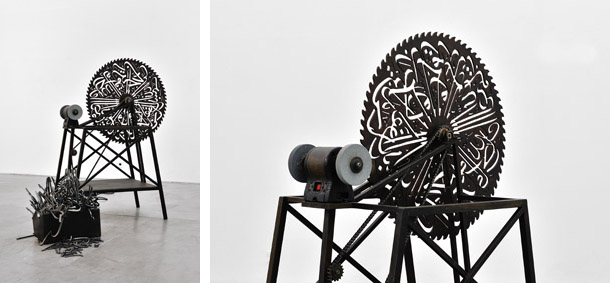
2013, Machine in steel, arabic calligraphy, engine, 75 x 100 x 116 cm.
Exhibition view of They were blind, they only saw images, Yvon Lambert, 2014, Paris.
Courtesy of the artist and Ceysson & Bénétière, Paris.
Ed. of 5 + 1 A.P.

2013, Machine in steel, arabic calligraphy, engine, 75 x 100 x 116 cm.
Exhibition view of They were blind, they only saw images, Yvon Lambert, 2014, Paris.
Courtesy of the artist and Ceysson & Bénétière, Paris.
Ed. of 5 + 1 A.P.
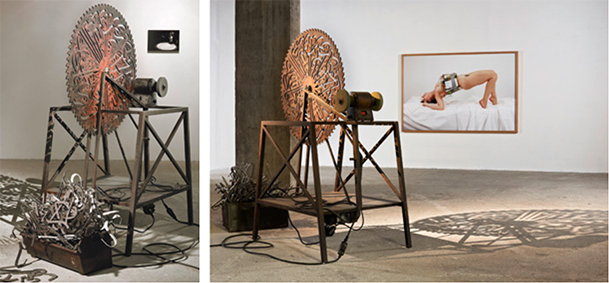
2013, Machine in steel, arabic calligraphy, engine, 75 x 100 x 116 cm.
Exhibition view of Walking on the light, CCC, 2014, Tours.
Courtesy of the artist and Ceysson & Bénétière, Paris.
Ed. of 5 + 1 A.P.
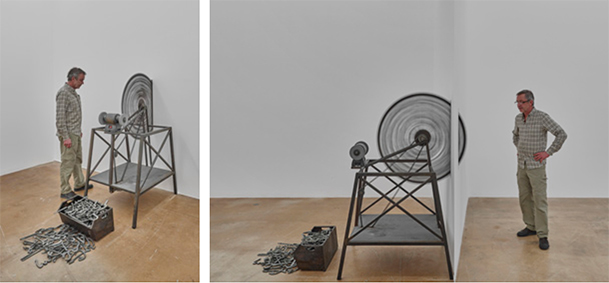
2013, Machine in steel, arabic calligraphy, engine, 75 x 100 x 116 cm.
Exhibition view of Permanent Exiles, MAMCO, 2015, Geneva.
Courtesy of the artist and Ceysson & Bénétière, Paris.
Ed. of 5 + 1 A.P.
Can the original meaning of words of religion be twisted into becoming the most dangerous of weapons?
François Salmeron, Paris-Art, 2014
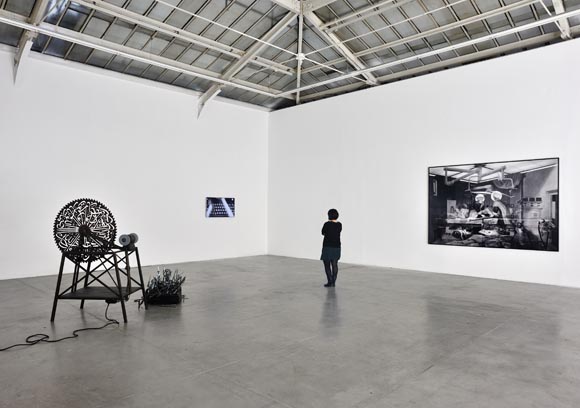
The Paradox
Exhibition view of They were blind, they only saw images, Yvon Lambert, 2014, Paris.
Courtesy of the artist.
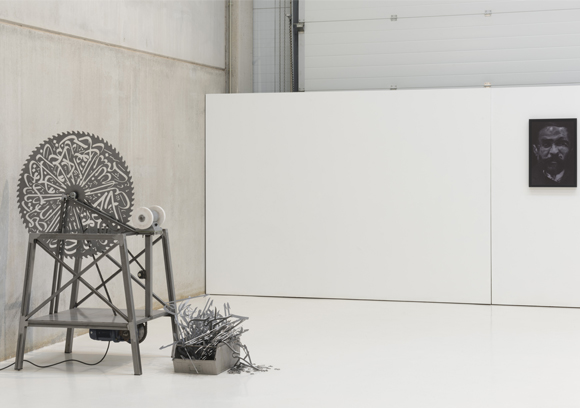
The Paradox
Exhibition view of The Index and The Machine, ADN Platform, 2016, San Cugat del Vallès.
Courtesy of the artist.
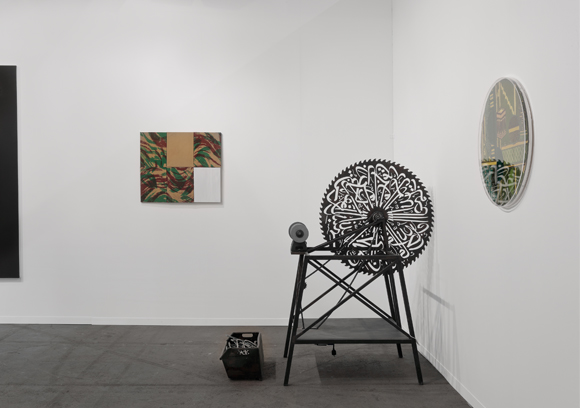
The Paradox
Exhibition view of Art Brussels, ADN Galeria, 2019, Brussels.
Courtesy of the artist.
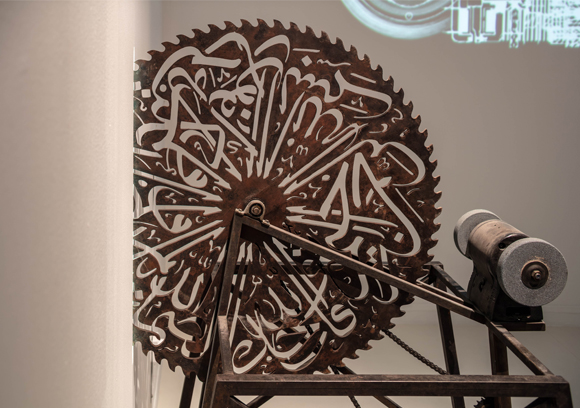
The Paradox
Exhibition view of 180° Behind Me, Göteborgs Konsthall, 2018, Göteborg.
Courtesy of the artist.

The Paradox
Exhibition view of 180° Behind Me, Göteborgs Konsthall, 2018, Göteborg.
Courtesy of the artist.
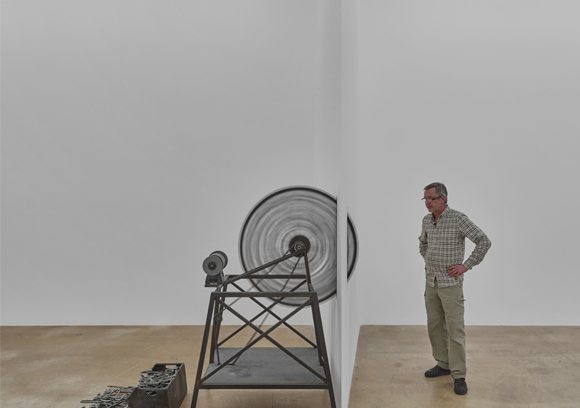
The Paradox
Exhibition view of Permanent Exiles, MAMCO, 2015, Geneva.
Courtesy of the artist.
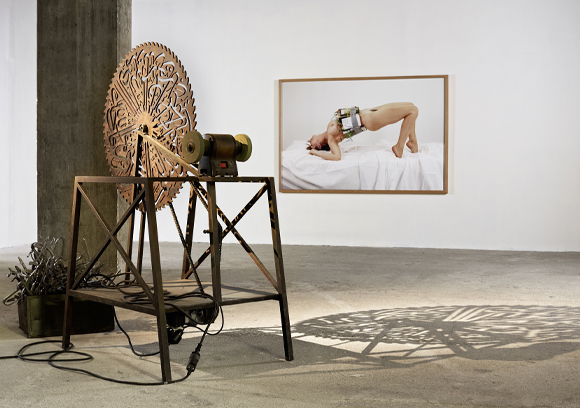
The Paradox
Exhibition view of Walking on the light, CCC, 2014, Tours.
Courtesy of the artist.
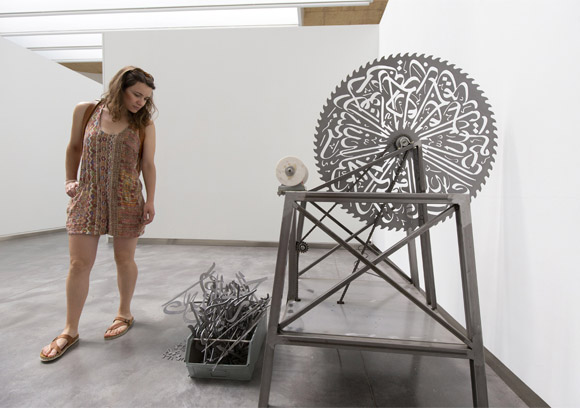
The Paradox
Exhibition View from The Day of the Awakening, CDAN, 2018, Huesca.
Courtesy of the artist.
|
|
|
|
|
|
Le Paradoxe est une œuvre sculpturale de mounir fatmi composée d’une machine à remouler obsolète et d’une lame de scie circulaire sur laquelle sont découpées des versets coraniques en langue arabe classique. Louant l’unicité de Dieu dans l’Islam, ces versets dispersés à la surface de la lame s’opposent à la Trinité chrétienne où subsiste une dimension humaine, celle du fils. Des éclats de ce même verset calligraphié sont dispersés autour de la machine, comme échappés de la surface de la lame. Cet effet est accentué lors de la mise en branle de la machine par un performeur, qui tente d’affuter ces bribes de texte sacré et continuer à alimenter la machine. De ce geste, l’homme décharge le texte symbolisé par ces objets de toute valeur religieuse.
L’apparente violence de l’objet renvoie à la notion d’arme tandis que l’abstraction formelle de la calligraphie brouille d’autant plus sa signification. Retrouvant son abstraction potentielle, le texte abandonne au sol le dogme issu de l’interprétation de l’écriture. Perdant ainsi son sens le texte, ses reliques dispersées et le mouvement de la scie incitent à remettre en circulation l’autonomie des idées et des mots. Invitant à réfléchir sur la pérennité doctrinale, le Paradoxe pose la question du libre arbitre face à la religion. Devenant ainsi une forme libre, le langage, aiguisé et tranchant, échappe à tout concept.
Le contraste frappant entre la fragilité du verbe et la rigueur du métal met en avant la torsion du sens. Ainsi, l’œuvre exhorte à la prudence vis à vis des messages religieux. Délaissé de sa charge sacrée, l’installation Le Paradoxe sonne comme un avertissement aux yeux du regardeur. Cette proposition radicale de mounir fatmi désigne les dangers et la fascinante obsession que le dogme peut provoquer. Le magnétisme opéré par le mouvement de la machine et son esthétisme va de pair avec la menace latente qu’elle implique. Si le texte sacré devient machine alors cette machine, elle, est le texte. Ainsi, plus on croit en la machine et plus elle est belle. Plus elle est belle, plus elle est dangereuse.
Studio Fatmi, Novembre 2016.
|
|
The Paradox is a sculptural work by mounir fatmi composed of an obsolete remolding machine and a circular saw blade from which Koranic verses in the classical Arab language have been cut. Praising the uniqueness of God in Islam, these verses scattered on the surface of the blade oppose the Christian Trinity as it contains a human element: the son. Shards of this same calligraphic verse are scattered around the machine, as if they had escaped from the surface of the blade. This effect is accentuated when the machine is set in motion by a performer, who tries to sharpen these pieces of text and continue to feed the machine. With this gesture, the man removes any religious value from the text symbolized by these objects.
The apparent violence of the object recalls the notion of weapons whereas calligraphy’s abstraction of form further blurs its meaning. Evoking its potential abstraction, the text abandons the dogma issued from the writing’s interpretation on the ground. As the text loses its meaning, its scattered relics and the saw’s movement invite the autonomy of ideas and words back into circulation. Beckoning reflection on doctrinal permanence, The Paradox poses a question of free will in the face of religion. Thus becoming a free form, the sharp and cutting language escapes any concept.
The striking contrast between word’s fragility and metal’s rigor emphasizes how meaning can be twisted. Thus, the work urges prudence vis-à-vis religious messages. Dispossessed of its sacred task, The Paradox installation presents itself as a warning to the eyes of the beholder. mounir fatmi’s radical proposition highlights the dangers and the fascinating obsession that dogma can provoke. The magnetism of the machine’s movement and its aestheticism go hand in hand with its latent, implied threat. If the sacred text becomes a machine, then the machine itself is the text. In this way, the more one believes in the machine, the more beautiful it becomes. The more beautiful it is, the more dangerous it becomes.
Studio Fatmi, November 2016.
Traduit du français par Christina Washington.
|
|
|
|